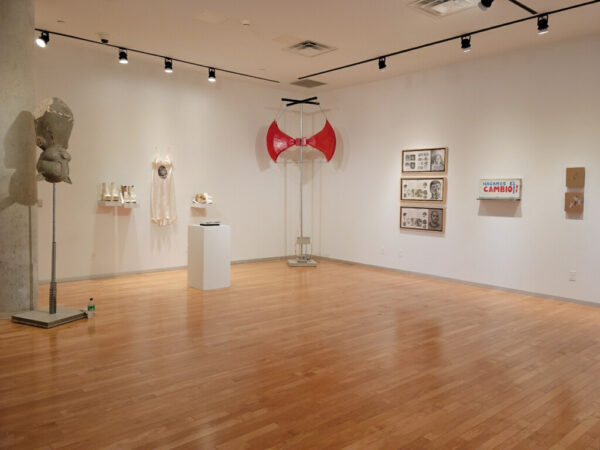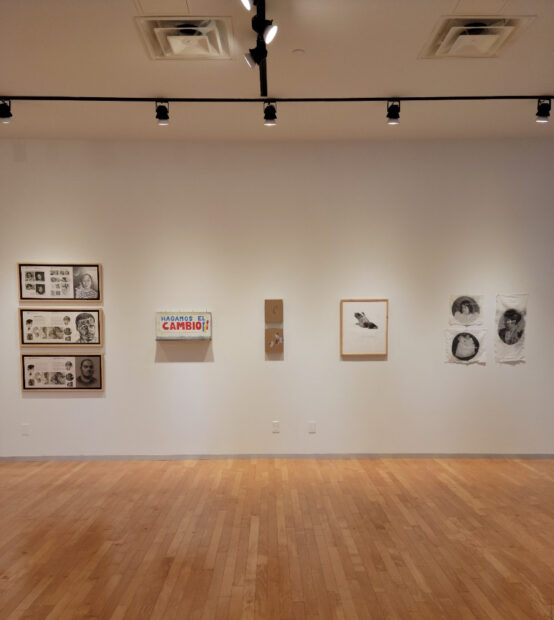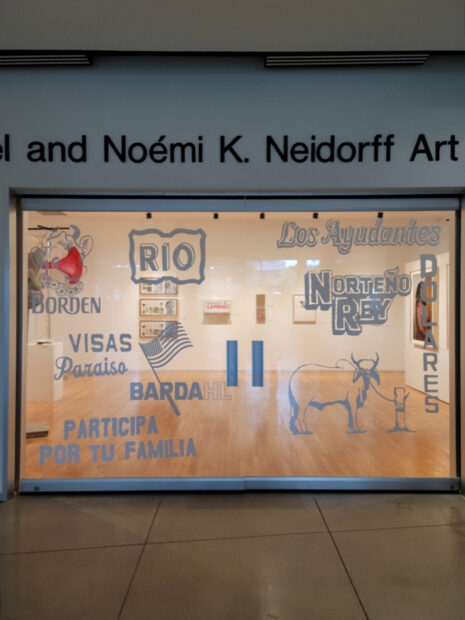
Participating artists in the 2023 CAM Perennial Exhibition, “Picking at Scabs,” curated by Gil Rocha.
Gil Rocha is an artist from Laredo, Texas., who holds an MFA from The School of the Art Institute of Chicago. Rocha was selected as the 2023 Contemporary Art Month Perennial curator, and produced an exhibition hosted by Trinity University titled Picking at Scabs, the result of an annual open call for artists. He approaches his own work with a rascuache aesthetic, a theory coined by scholar Tomás Ybarra-Frausto that references working class Chicano people and their struggles as a means of empowerment.
This year’s perennial includes artists Juan Carlos Escobedo, Anthony Francis, Melissa Gamez-Herrera, Violeta Garza, Pedro Morales, Theresa Newsome, Erika Ordoñez, Anthony Rundblade, Alán Serna, and Gary Sweeney.
I had the opportunity to talk to Gil Rocha about this year’s exhibition.
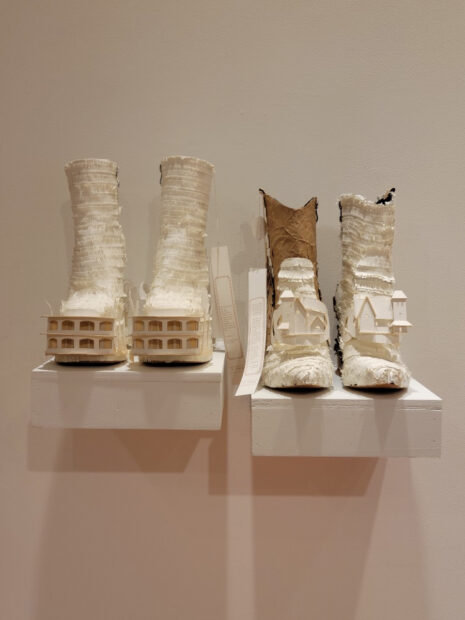
Work by Juan Carlos Escobedo on view in the 2023 CAM Perennial Exhibition, “Picking at Scabs,” curated by Gil Rocha.
Kayla Padilla (KP): Can you tell me about the process of selecting the artists and works for the exhibitions? What were you looking for?
Gil Rocha (GR): I approached this show by selecting artworks that really caught my attention. I want to say that I reduced the number of artists that applied to the open call to about eighty. I still had a lot, so I started listening to the words, to their statements, and got an idea of what was attracting my attention formally and conceptually. I kept cutting until eventually I ended up with 10 artists. I was like, “okay, what works do I think fit with another artist? And can the works talk to each other?” A week before the exhibition, the installation happened, and that’s when I felt right about it.
KP: Though in recent years the annual exhibition has been focused exclusively on San Antonio artists, this year’s call is open to artists living and working in San Antonio or Laredo. Why is it important to be inclusive of the Laredo area?
GR: San Antonio has so many organizations and museums, and the ease at which you can go on any given day and see really good exhibitions is something that we don’t have in Laredo. It’s two hours away, and the trip feels doable, so I thought, “let’s bring that same quality of artwork back to Laredo.” From the perspective of San Antonio, I think it’s great to invite other communities. It’s about getting this new perspective — even though it’s a small community — but the artists have been formally trained. One of them, Pedro Morales, is an architect. He studied and worked for a while with Frank Gehry as an assistant many years ago. Erika Ordoñez is a teacher, but she’s also been a practicing artist for many years.
KP: Can you tell me a little bit about the demographics of the artists being showcased? Ages? Backgrounds?
GR: As far as the age group, they’re all between 30 and 40. Once I started selecting the work that I liked — just based on the work, not reading who the artists were or their statement or anything — I did notice that many of them have been really well trained in the arts. There’s the work of Theresa Newsome, who submitted photographs, including a picture of a cigarette and a picture of an iced tea. For some reason, they really caught my attention. There’s also Anthony Francis. When I saw his portraits, I saw objects. I see objects all the time, but to me they just has that x factor. You can’t get them out of your mind. Anthony’s portraits are of people, but at the same time, the portraits are of the hands. It’s these subtle gestures; they’re just beautiful. Once I started reading more about what their work was about, it was like, okay, I understand now why I really like it. It’s not just a portrait. It’s not just a picture. The objects that Theresa had were objects that were found in the pockets of people murdered by the police. When you have something like this, it’s like, okay — this is something else.
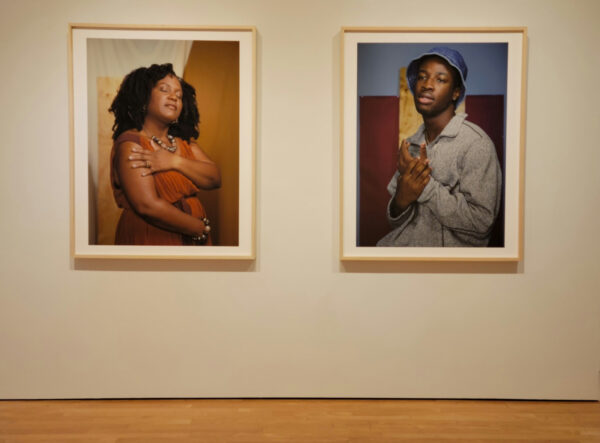
Work by Anthony Francis in the 2023 CAM Perennial exhibition “Picking at Scabs,” curated by Gil Rocha.
KP: Why did you choose to title the exhibition Picking at Scabs?
GR: As a kid, you would fall. You’d have that scab, and just pick at it. There’s a little bit of pain, but I think that the scab itself, to me, represents something at the current state. It’s not something about to happen, and it’s not a wound that has already been sealed. In my statement, I mentioned that these artists have stories that have been passed on from their grandparents, great grandparents, and their parents. These are stories they may or may not still be going through. I feel that the work is a reaction to not only their personal journey, but also those of their parents and their grandparents.
KP: This year’s exhibition is being held at the Michael and Noemi Neidorff Art Gallery at Trinity University. How often does the location of the annual exhibition change?
GR: I think they host it in different places to give other organizations the opportunity. It’s great because it changes the space; the curator changes their whole concept. It’s very organic, and I really like that.
And the other thing I’ve been thinking about is that (I mean, it’s kind of late now, but still) with enough time later on, maybe it could be a traveling show. It’s in San Antonio, maybe it would have been great to bring it to Laredo. Maybe we still can. The show’s already been put together, so with all this hard work, might as well.
KP: Can you tell me a little bit about your own artwork? One of the things you like to do is make structures with discarded objects. Can you tell me how you started doing that, and how you began to see everyday objects as vehicles for your art?
GR: I think it’s finally clicked that it’s not how I saw my work but it’s how I unsaw it. When we were kids, I remember I used to build forts made out of towels and chairs with my cousins. When you don’t have many toys, a pencil becomes a machine gun. It becomes an action figure, an airplane. I think as we grow older, we start getting an understanding of our own art.
I’m also an educator. I feel that we tend to give credit to the kids that can copy things a little more realistically, and we tend to tell them, “Oh, you’re such a great artist.” So the other kids kind of get discouraged, not knowing that you can make art and it doesn’t have to be realistic. After attending undergrad, and then grad school, I’ve worked with these kinds of objects. I feel that now I’m playing, but there’s also this whole thing where, yeah they’re everyday objects that we tend to use, but they’re very important to me. I really like extending the art history conversation. To me, there are different layers. So if you pay attention, just at the first level, you’ll see this interesting object. Second level, there’s more to it. And then even deeper than that, to me, is where I have hidden gems.
KP: Can you talk about the intersection of your own parents and art?
GR: I go to my parents’ house and I see all these makeshift things that my dad creates for functionality, like building dog houses, or if a piece of fence breaks, he’ll tie it up. I started talking more to my dad about how I was appreciating all these things and what I was seeing. One time, I went to go visit him and he’s like, “hey, come over here. I want to show you something.” He had done something to a bench where he put a piece of skateboard underneath. And then he looked at me, but in a way that a kid would look at a parent. So I was like, “oh, man looks great.” But at the same time, I thought, “I’m taking away that rawness that he has.” It felt sort of the same as when we were kids and we were told, “you shouldn’t go past the line,” or “you shouldn’t paint the tree blue.” So I felt kind of the same thing. Now I don’t tell him anything.
KP: You have a portrait called “my grandmother” that really drew my attention because of how familiar it felt: the face, the hairstyle, the clothing in the picture. Could you tell me more about that portrait and what it was like to make it?
GR: I think it was from a picture, and I can’t recall whether I did it after she passed. She was already getting older, so I felt the need to document her. In that piece, I was trying to capture more than her face — I guess, just the subtle warmth that I felt when I was with her.
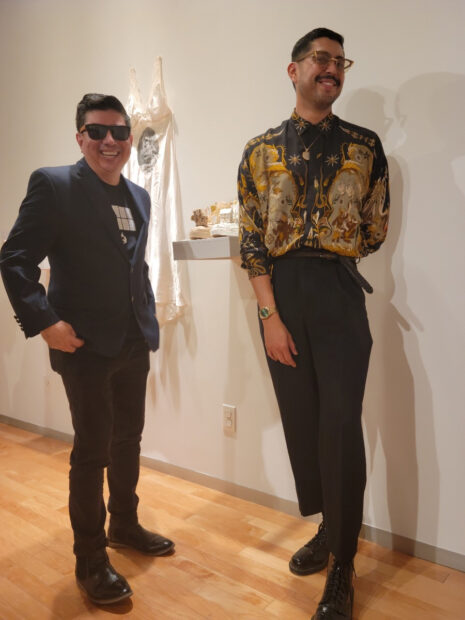
CAM Perennial curator Gil Rocha with artist Juan Carlos Escobedo at the 2023 CAM Perennial Exhibition, “Picking at Scabs.”
KP: Can you tell me a little bit about your background and what you do for work?
GR: I’m an art teacher at a magnet school. I teach painting and drawing, but we also have another art teacher that teaches sculpture. I pretty much teach two-dimensional stuff, printmaking and all that. But in the school, we also have music of all sorts: piano, trumpet, guitar, and electric guitar. We have ballet, we have folklorico, we have hip hop. We have everything, and I think that it’s such an amazing school.
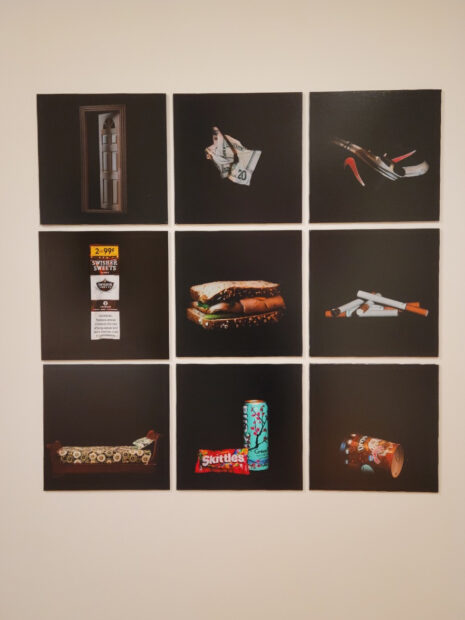
Work by Theresa Newsome in the 2023 CAM Perennial Exhibition, “Picking at Scabs,” curated by Gil Rocha.
KP: What advice do you have for people who thought of submitting their work but didn’t because they were nervous, or maybe don’t think they have enough experience to be in the show? Maybe they’ll be encouraged to submit next year after hearing from you.
GR: Just go for it. I mean —maybe this is not the right thing to say — but there has to be an appreciation for these sorts of rejections and failures in your work. I’ve been through it so much, and eventually it’s like, “I’ve felt this before, let’s move on. Let’s keep trying.” It’s about bettering yourself through looking at what other people are doing, and just trying your hardest to be authentic. I know that I could make a lot of money from doing portraits. I’ve done them at times when I’m struggling a little bit financially. I’ll go back and I’ll do portraits. But that’s not what I really want to do. So I would advise an artist to just keep doing what you love, keep going your authentic way. It’s a matter of time, and the process just becomes easier.
Picking at Scabs is on view at Trinity University through April 8, 2023.
Kayla Padilla is the 2023 recipient of Contemporary Art Month, San Antonio‘s Critical Writing Fellowship.


